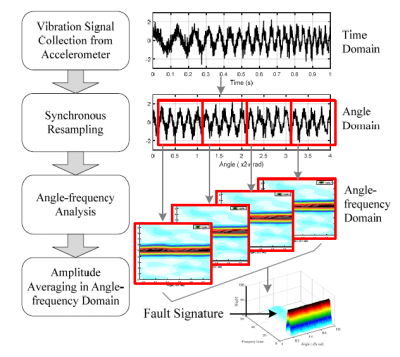Gear fault diagnosis relies heavily on the scrutiny of vibration responses measured. In reality, gear vibration signals are noisy and dominated by meshing frequencies as well as their harmonics, which oftentimes overlay the fault related components. Moreover, many gear transmission systems, e.g., those in wind turbines, constantly operate under non-stationary conditions. To reduce the influences of non-synchronous components and noise, a new fault signature enhancement method that is built upon angle-frequency domain synchronous averaging is developed at DSCL. Instead of being averaged in the time domain, the signals are processed in the angle-frequency domain to solve the issue of phase shifts between signal segments due to uncertainties caused by clearances, input disturbances, and sampling errors, etc. The framework of the method is illustrated in the Figure 1.
Figure 1. Flow diagram of fault signature enhancement based on angle-frequency domain synchronous averaging
To demonstrate the effectiveness of this technique, a case study is carried out on a gearbox with five different pinion health conditions as shown in Figure 2.

Figure 2. Five pinions with different health conditions.

Figure 3. Enhanced spectrograms under (a) missing tooth, (b) root crack, and (c) spalling conditions from angle-frequency domain synchronous averaging.
The enhanced results obtained through angle-frequency domain synchronous averaging, shown in Fig 3, are then analyzed by using feature extraction algorithms to identify the most distinct features for fault classification and identification. Specifically, Kernel Principal Component Analysis (KPCA) targeting at nonlinearity, Multilinear Principal Component Analysis (MPCA) targeting at high dimensionality, and Locally Linear Embedding (LLE) targeting at local similarity among the enhanced data are employed and compared to yield insights. Numerical and experimental investigations are performed, and the results reveal the effectiveness of angle-frequency domain synchronous averaging in enabling feature extraction and classification. The results are plotted in Figure 4.

Figure 4. Experimental feature extraction results in a 2D reduced metrics spaces from (a) KPCA with Gaussian Kernel, (b) MPCA, and (c) LLE.
This case study illustrates that angle-frequency domain synchronous averaging can significantly enhance the fault-related features. The combination of feature enhancement with the feature identification algorithms can yield effective fault detection and identification.